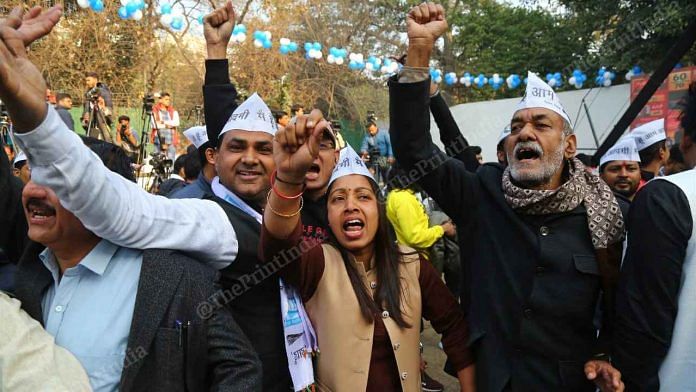New Delhi: By 9 am, the Aam Aadmi Party (AAP) was leading in 43 of the 70 assembly seats in Delhi, early trends based on postal ballot votes showed.
The Arvind Kejriwal-led party had a clear edge over the BJP, which was leading in 16 seats improving over its 2015 tally. The Congress doesn’t seem to be in the reckoning.
These are, however, very early trends. A more clear picture will emerge after the next round of counting.
According to CNN-TV 18, Kejriwal, who is the AAP’s CM face, is leading from his New Delhi constituency against main opponent, the BJP’s Sunil Yadav. So are the other AAP leaders, including Deputy CM Manish Sisodia, Somnath Bharti, Saurabh Bhardwaj, Gopal Rai, and Raghav Chadha.
If the trend continues, AAP could be heading for its third stint at power in Delhi since 2013, when it made its mark in Delhi’s electoral landscape for the first time, winning 28 seats.
Led by Arvind Kejriwal, and with outside support from the Congress, the AAP formed the government in the city-state, ending the 15-year Congress rule. The government was short lived, though, and fell after 49 days. But the AAP returned to power with a thumping majority in 2015, when it won 67 of the 70 seats.
The Shaheen Bagh effect
The election trend is a reflection of how the BJP’s polarising campaign around anti-CAA protests at Shaheen Bagh — where Muslim women sat on protest against the citizenship law bought by the Narendra Modi-led NDA government — has had a bearing on the outcome.
At 9.30 am, according to CNN-TV18, BJP’s Brahm Singh was leading from the Okhla seat — Shaheen Bagh and Jamia Nagar are part of this constituency — against AAP’s Amanatullah Khan.
This election has been one of the most polarised ones in Delhi in recent times with the BJP using the Shaheen Bagh protests as its most important campaign theme.
The AAP campaign, meanwhile, revolved around Chief Minister Arvind Kejriwal and his model of good governance and development, especially the freebies. “Acche beete paanch saal, lage raho Kejriwal” was the theme of AAP campaign.
In doing so, the AAP consciously chose to keep away from negative issues. Kejriwal and his party leaders avoided getting drawn into a debate on Shaheen Bagh protests.
Kejriwal makeover & AAP governance
The AAP government had earlier come out with a report card for the party, including free power for consumption up to 200 units, 50 per cent subsidised power for consumption between 200 and 400 units, free water up to 20,000 litres a month, providing free bus and metro rides for women, setting up WiFi points and mohalla clinics.
Kejriwal had also gone on an overdrive to ensure an image makeover — from an anti-corruption activist who preferred ‘anarchism’ even after becoming the chief minister into a leader and an effective administrator. He adopted the same for his constituency campaign too.
The AAP chief was seen resorting to a time-tested political strategy — create a personality cult that would paper over all failures in governance and politics over the past five years. From video conferences, mobile apps, metro stations, auto stands to hoardings on roads or full-page newspaper advertisements and even your drawing rooms (WelcomeKejriwal.In), Kejriwal’s face was all over Delhi so that he could effectively highlight his government’s achievements.
Several political analysts credit his victory to the tried and tested strategy. The new Kejirwal is no longer an angry young man; he smiles and laughs, cracks jokes in speeches, and improvises when the situation demands it.
Since many people in his party believed that people like a positive campaign, Kejriwal stuck to this evolved image. Election strategist Prashant Kishore’s suggestions clearly seem to have gone in his favour. The town hall meetings held by Kejiwal during the campaign also reiterated the subtle attempt at rebuilding his image as a communicator instead of a leader who speaks only in monologues without listening.
Also read: Kejriwal ducks Team Shah’s bodyline bowling in Delhi, but slog overs will test his patience






